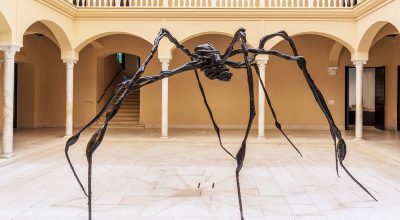
A Woman Looking at Men Looking at Women
Grażyna Kulczyk (1950) is an entrepreneur and art collector, whose endeavours have made her Poland’s most successful businesswoman. She began building her collection while still in law school during the 1970s and, in 2015, she joined the board of the Modern Women’s Fund Committee of the Museum of Modern Art, New York. A few months ago, she founded Muzeum Susch, a new contemporary art institution seated in the Swiss Alps. The inaugural exhibition, A Woman Looking at Men Looking at Women, takes its point of departure from the significant emphasis on women artists at the core of her collection.
“I am delighted to inaugurate my new museum with this exciting exhibition showing work by some of the most pioneering women artists of the twentieth and twenty-first centuries. Tracing a matrilineage through art history is a mission central to my collection and a personal passion. Many of the artists shown in this exhibition have been underrepresented previously. Through the ongoing activities of Muzeum Susch and its disruptive outlook to the future we now have a great chance to bring works such as these to a wider audience and the recognition they deserve,” she says.
A Woman Looking at Men Looking at Women is curated by Kasia Redzisz, Senior Curator at Tate Liverpool, and borrows its title from Siri Hustvedt’s 2012 essay of the same name which analyses the perceptual bias that affects how an individual reads art and the wider world. The exhibition weaves the narrative of artists who, regardless of gender, have been able to challenge not only social norms but also the limitations of art and its restrictive categories. It sets out to explore the notion of the feminine and its diverse facets: social, political and cultural.
Redzisz brings together work by over 30 international artists, featuring loans drawn from public institutions, artists’ estates, and private collections, as well as pieces from the Grażyna Kulczyk collection. Central to the artists and works represented is a commitment to experimentation and to pushing the boundaries of artistic practice.
The themes of the exhibition address several issues central to feminist theory, moving from conventions of female representation through sexual emancipation to the challenging and subversion of traditional gender roles. “Rather than reiterating established polemics, this exhibition seeks to offer a fresh perspective on the paradoxes of the feminine expressed through art”, Curator Kasia Redzisz says. In the selection of works on display, the female gaze predominates; the body is a source of pleasure rather than an ideological battlefield; and motherhood and domesticity are marked not only by tenderness but also by anxiety.
Hannah Wilke’s iconic performance, Hannah Wilke Through the Large Glass (1976), opens a discourse on the politics of representation and paves the way to works by prominent feminist artists such as Marlene Dumas, Sarah Lucas, Betty Tompkins and Joan Semmel, which challenge the traditional dominance of the male gaze.
The narrative embedded in the exhibition is frequently conveyed through bodily gestures and sensations, from Maria Lassnig’s “body awareness” paintings to Lucio Fontana’s violently slashed canvases. Fontana’s works have often been associated with the power and authority of (the male) artistic gesture. Here, his Concetto Spaziale (Spatial Concept) [1968] is juxtaposed with ground-breaking textile sculptures by Magdalena Abakanowicz, prompting reflections on female symbolism and the male-dominated art historical canon.
Departing from feminist iconography, the exhibition also celebrates pioneering women artists who challenged artistic categories in search of new means of expression. Carla Accardi, Helena Almeida, Laura Grisi and Kiki Kogelnik all questioned the notion of painting, breaking away from the constraints of its classical definition. Their experimental approach is mirrored in the sculptural practice of Alina Szapocznikow and Maria Bartuszová, whose sensual works speaking of the body and desire are also on display. Other aspects of the feminine, sexuality, motherhood, and the sphere of domesticity are further explored through groupings of works by artists including Louise Bourgeois, Geta Brătescu, Nicole Eisenman, Carol Rama and Erna Rosenstein, all of whom uncompromisingly challenged cultural taboos and contested the constrictions of their chosen media.
A WOMAN LOOKING AT MEN LOOKING AT WOMEN
Muzeum Susch, Surpunt 78, Susch, Switzerland
Until June 30th, 2019
Featured image: From left to right: works by Maria Lassnig, Teresa Pagowska, Judith Bernstein, Wojciech Fangor, Marlene Dumas, Sylvia Sleigh, Sarah Lucas (sculpture). Installation view of A Woman Looking at Men Looking at Women. Courtesy: Art Stations Foundation CH, Muzeum Susch © Błażej Pindor for Muzeum Susch / Art Stations Foundation CH
También te puede interesar
Lo Manual y lo Artesanal en la Obra de 40 Artistas Mujeres
La muestra Entangled: Threads & Making, que se presenta actualmente en Turner Contemporary (Margate, Reino Unido), reúne a más de 40 artistas mujeres internacionales de varias generaciones, quienes comparten una intensa curiosidad por los...
RETROSPECTIVA DE LOUISE BOURGEOIS EN ESPAÑA
El Museo Picasso Málaga acoge hasta el 27 de septiembre de 2015 la mayor retrospectiva de Louise Bourgeois hasta ahora organizada en España, una presentación que incluye más de cien obras realizadas por la artista a lo…
ON THE EDGE OF VISIBILITY – AN INTERNATIONAL SYMPOSIUM
This symposium offers a transcontinental approach and encompasses postcolonial, feminist, and queer perspectives. Topics discussed will consider the concerns and complexities of defining what it means to be a Black or Indigenous woman artist...









